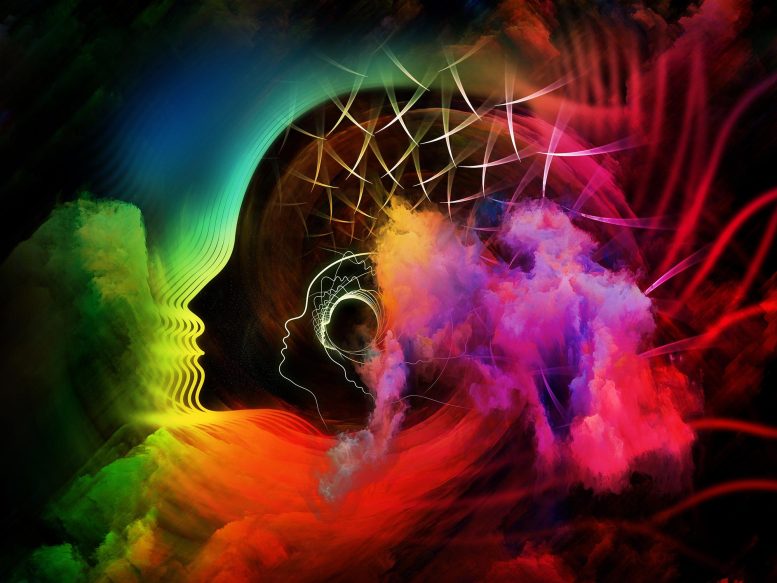
A recent study used infants to investigate the origins of purposeful action, showing that agency emerges from the relationship between an organism and its environment. Using a baby-mobile experiment, researchers demonstrated that when infants recognize their ability to cause motion in the mobile through their movement, they transition from spontaneous to intentional behavior, marking the “birth of agency.”
The research on infants provides the first quantified observations showing the ’emergence’ of agency or purpose in humans.
Living things act with purpose. But where does purpose come from? How do humans make sense of their relation to the world and realize their ability to effect change? These fundamental questions of agency – acting with purpose – have perplexed some of the greatest minds in history including Sir Isaac Newton, Charles Darwin, Erwin Schrödinger, and Niels Bohr.
New research from Florida Atlantic University reveals groundbreaking insight into the origins of agency using an unusual and largely untapped source – human babies. Since goal-directed action appears in the first months of human life, the FAU research team used young infants as a test field to understand how spontaneous movement transforms into purposeful action.
For the study, infants began the experiment as disconnected observers. However, when researchers tethered one of the infants’ feet to a crib-mounted baby mobile, infants discovered they could make the mobile move. To catch this moment of realization like lightning in a bottle, researchers measured infant and mobile movement in 3D space using cutting-edge motion capture technology to uncover dynamic and coordinative features marking the “birth of agency.”
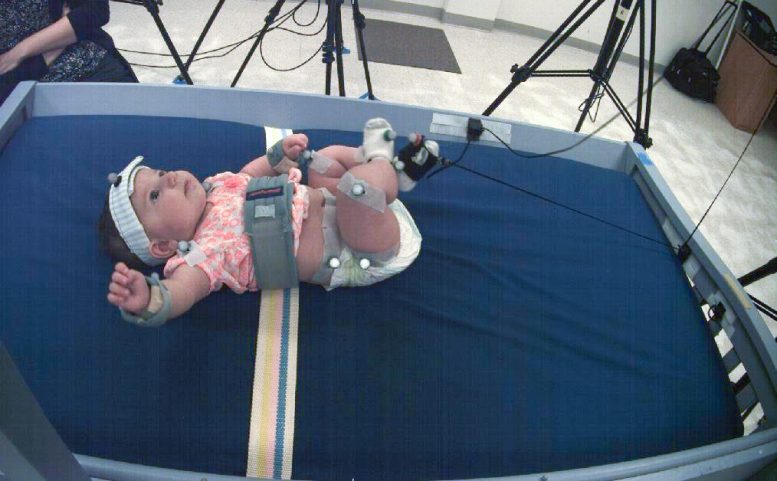
When an infant’s foot is tethered to the mobile, each foot movement causes the mobile to move. Positive feedback amplifies and highlights the cause-and-effect relationship between infant and mobile motion. Credit: Florida Atlantic University
Recent findings, published in the Proceedings of the National Academy of Sciences, provide a solution to this age-old conundrum. Analysis and dynamical modeling of experiments on human infants suggest that agency emerges from the coupled relation between the organism (baby) and the environment (mobile). But how exactly does this happen?
When an infant’s foot is tethered to the mobile, each foot movement causes the mobile to move. It was thought that the more the mobile moves, the more the infant is stimulated to move, producing yet more mobile motion.
“Positive feedback amplifies and highlights the cause-and-effect relationship between infant and mobile motion,” said J.A. Scott Kelso, Ph.D., senior author and Glenwood and Martha Creech Eminent Scholar in Science at the Center for Complex Systems and Brain Sciences within FAU’s Charles E. Schmidt College of Science. “At some critical level of coordination, the infant recognizes its causal powers and transitions from spontaneous to intentional behavior. This aha! moment is marked by an abrupt increase in infant movement rate.”
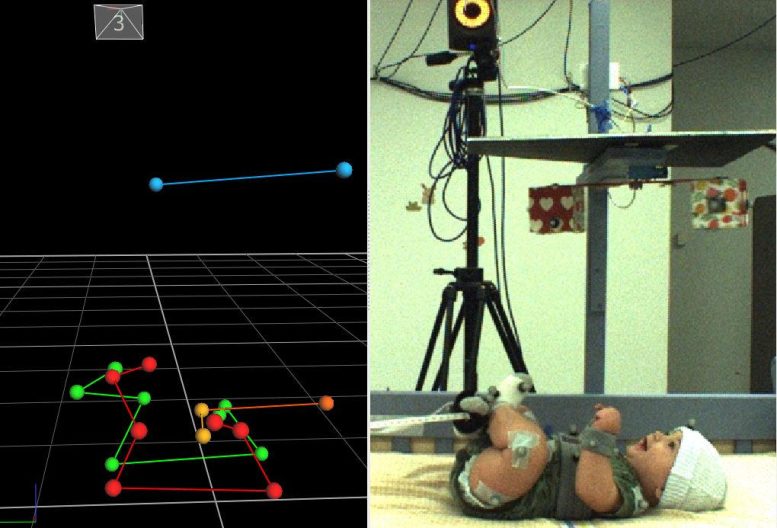
A 3D reconstruction/representation of the positions of the infant’s joints (red = left side; green = right side; yellow/orange = center; and the mobile’s position = blue). The image to the right depicts little silver spheres placed on the baby’s skin at different joints. Special cameras send out infrared light, which bounces off the spheres and reflects back to the cameras. The system then takes that reflective infrared information from all the cameras and figures out the exact location of each sphere. Credit: Florida Atlantic University
Aliza Sloan, Ph.D., lead author and a postdoctoral research scientist in FAU’s Center for Complex Systems and Brain Sciences, developed a quantitative “aha!” detector to search for abrupt increases in infant movement rate related to sudden infant discovery.
Sloan’s technique demonstrated that the “birth” of agency can be quantified as a “eureka-like,” pattern-changing phase transition within a dynamical system that spans the baby, the brain, and the environment. The system switches from a less correlated state to a state where both movements of the mobile and the tethered limb are highly coordinated as the infant discovers its functional connection to the mobile.
Although the basic design of the experiment has been used in developmental research since the late 1960s, related research traditionally focused solely on infant activity, treating the infant and environment as separate entities. In the 50 years of formal baby-mobile experiments, the FAU study is the first to directly measure the motion of the mobile and to use coordinative analysis to provide quantified observations of the emergence of human agency.
The new approach used in this study frames agency as an emergent property from the functional coupling of organism and environment. Researchers took a deep dive into the baby-mobile interaction through the eyes of Coordination Dynamics – Kelso and colleagues’ theory of how complex living things are coordinated (from cells to society) and how function and order emerge.
When an infant’s foot is tethered to the mobile, each foot movement causes the mobile to move. Positive feedback amplifies and highlights the cause-and-effect relationship between infant and mobile motion. At some critical level of coordination, the infant recognizes its causal powers and transitions from spontaneous to intentional behavior. This aha! moment is marked by an abrupt increase in infant movement rate. Credit: Florida Atlantic University
Although it was expected that infants would discover their control over the mobile through their coordinated action with the mobile, patterns of infant pausing were striking.
“Our findings demonstrate that it’s not just the infants’ active movements that matter,” said Nancy Jones, Ph.D., co-author, professor in FAU’s Department of Psychology and director of the FAU WAVES Lab.
A complete coordinative analysis of baby motion, mobile motion, and their interaction, found that the emergence of agency is a punctuated self-organizing process, with meaning found both in movement and stillness.
“The babies in our study have revealed something really profound: that there is action in the midst of inaction, and inaction in the midst of action. Both provide meaningful information to the infant exploring the world and its place in it,” said Kelso. “The coordination dynamics of movement and stillness jointly constitute the unity of the baby’s conscious awareness – that they can make things happen in the world. Intentionally.”
The FAU study also revealed that infants navigate functional coupling with the mobile in different ways. Distinct clusters in the timing and degree of bursts of infant activity were detected, suggesting that behavioral phenotypes (observable characteristics) of agentive discovery exist – and that dynamics provide a means to identify them. This novel phenotyping method may be useful for preventive care and early treatment of infants at risk.
Reference: “Meaning from movement and stillness: Signatures of coordination dynamics reveal infant agency” by Aliza T. Sloan, Nancy Aaron Jones and J. A. Scott Kelso, 18 September 2023, Proceedings of the National Academy of Sciences.
DOI: 10.1073/pnas.2306732120
This research was supported by the FAU Foundation and by National Institute of Mental Health (MH-080838) of the National Institutes of Health.

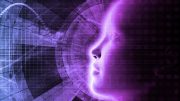

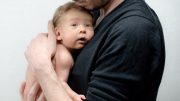

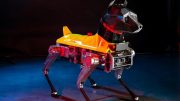



Reminds me of the baboon exhibits at zoos; watching the observers is more interesting than the exhibit.
@Liz hahaha!! This is the humor much needed to start emerging from today’s mental black hole. Thank you internet stranger. I hope you find yourself some joy in something seemingly unnoticeable, someone random makes your day, or discover a fun yet socially useless hobby to spend time with yourself free from outside pressure and influence. Peace love and light to you .
Lady Goodman, happens all the time, in fact the only reason I came back to this article was because I didn’t want it to ruin the rest of my day. How, on Earth do these researchers reach the conclusion that this experiment in anyway proves the birth of consciousness? By the same reasoning, I suppose that if one had taken away all of Stephen Hawking’s means of communication, we could then say that he had no consciousness either; I remember my early childhood and all the difficulties that I had learning how to manipulate the body that I was born into; I was definitely fully conscious before these researchers would have ever detected it, but I understand how it is that, they might think that way, because I’ve been closely observing human behavior since long before I knew their language and all the B.S. that they pull on each other; and after all this time, after what DNA anthropologists claim to have become human, you all are still fighting wars, killing each other, and claiming, some how that as a species you are both intelligent and humane? LOL, consciously or otherwise this research was both politically and theologically motivated; and hence, the meaning of my original comment, I see it in just about every single branch of science that the humans engage in, I even possess your flesh; look around yourselves;
you’re about to kill yourselves off; and you think that you’re conscious? Please! Get over yourselves, the only thing that really gives you an advantage over the other animals are your hands; otherwise really, you humans are really stupid, I’ve even met some of you humans who were so lacking in so-called mental abilities that couldn’t even sign their names and were very proud that they knew what day of the week it was, and they were obviously much more intelligent than anyone else in the room; so what all are you really measuring? It’s not really intelligence or this experiment; maybe it’s just an imaginary manifestation of yourselves; anyway it’s a dead species it’s starring you right in your face and you can’t even see it; so tell me that some how you all are conscious when scientifically speaking you are anything but
I believe your argument is supported by the fact that not one person has commented on your statement about “possessing (human) flesh”.
I don’t feel there is any actual discovery here. Mothers have played music to babies on the womb that respond to the music or to thier moms voice, I belive all they have captured is the baby’s realization that they could influence the mobile, not a birth of consciousness. Is this what our schools are passing off as an accomplishment now? I see no discovery with this shallow thinking, non-discovery. Seems more like a fake accolade and people trying to pat themselves on the back.
I know I have a strong memory of my existence practically from day 1. I’m now in my 70s. I agree that this experiment just shows a baby can discover and react and be creative interacting with his or her environment. Maybe the scientists should define what they mean by or what they consider qualifies as ‘consciousness’. I’d say there is a spectrum of consciousness which we all experience to some extent from near zero or lets say zero to bright like the sun (over simplifying like 100). At some point on that daily fluctuation across parts of that spectrum we can be aware of our immediate environment more or less and interact with parts of it. But then are we the pin ball in or the player of the game in the pinball machine of life, or both? I think we can be conscious regardless of what environment we are in, sitting still or twiddling our thumbs or trying out a musical instrument. But I wouldn’t conclude the scientists are anything but conscious. We humans are all more or less similar and I assume that includes you and me. Us aside, I think the experiment shows a baby is curious about his environment and learns at least in part by interacting with it, and becomes aware of how he can interact with it. I think your point was that he was already conscious at least to some extent and I would agree with that. Like when I first saw my last name on my wristband in a crib in the nursery and I wondered WTF (paraphrasing) am I looking at. Conscious or being was a given but I was wondering. I was really curious what I was looking at. I wasn’t really aware of myself yet. Did that make me unconscious?
Liz Grant – you are right on the money. As a retired biological scientist, I think the interpretation of this study is very unscientific
“Agency”, “Consciousness”, blah, blah, blah. This is B. $. Study full of Non-sense. These “smart” people are Idiots…
Talking about the “process” by which “agency” arises (self-organizing systems driven by external feedback) still doesn’t address the nature and origin of consciousness — subjective experience in and of itself.
A mouse develops “agency”, action connected to reaction. Is a mouse “conscious” in the way a human is? The study was on realizing agency. Consciousness is a much more complicated thing. The title is nothing more than clickbait.
Lol with all the pseudoscience and borked studies, no wonder no one knows what the hell fact is these days. Also click bait article titles are click bait. Lemme go make another study on why coffee is simultaneously good and bad for everyone in existence, based on my own personal test group of one. I guess people gotta publish those papers to make that $, and people gotta hype those papers up for that ad $.
It’s becoming clear that with all the brain and consciousness theories out there, the proof will be in the pudding. By this I mean, can any particular theory be used to create a human adult level conscious machine. My bet is on the late Gerald Edelman’s Extended Theory of Neuronal Group Selection. The lead group in robotics based on this theory is the Neurorobotics Lab at UC at Irvine. Dr. Edelman distinguished between primary consciousness, which came first in evolution, and that humans share with other conscious animals, and higher order consciousness, which came to only humans with the acquisition of language. A machine with only primary consciousness will probably have to come first.
What I find special about the TNGS is the Darwin series of automata created at the Neurosciences Institute by Dr. Edelman and his colleagues in the 1990’s and 2000’s. These machines perform in the real world, not in a restricted simulated world, and display convincing physical behavior indicative of higher psychological functions necessary for consciousness, such as perceptual categorization, memory, and learning. They are based on realistic models of the parts of the biological brain that the theory claims subserve these functions. The extended TNGS allows for the emergence of consciousness based only on further evolutionary development of the brain areas responsible for these functions, in a parsimonious way. No other research I’ve encountered is anywhere near as convincing.
I post because on almost every video and article about the brain and consciousness that I encounter, the attitude seems to be that we still know next to nothing about how the brain and consciousness work; that there’s lots of data but no unifying theory. I believe the extended TNGS is that theory. My motivation is to keep that theory in front of the public. And obviously, I consider it the route to a truly conscious machine, primary and higher-order.
My advice to people who want to create a conscious machine is to seriously ground themselves in the extended TNGS and the Darwin automata first, and proceed from there, by applying to Jeff Krichmar’s lab at UC Irvine, possibly. Dr. Edelman’s roadmap to a conscious machine is at https://arxiv.org/abs/2105.10461
Suppositions
1. Lady Goodman is a man.
2. Science skeptics have become so brazen that they don’t mind publicly making fools of themselves in commenting on things they have no clue about or not offering any evidence for their claims.
3. I think we all know by now that they have gotten their inspiration and courage to do what they’re doing from their cult leader – the stable genius himself.
Good article.. and inspiring..
Why is there so much repetition in this article? Did you have to hit certain word count or are you just intentionally making it a streasfull time wasting experience to read your stuff. Thanks for existence of LLMs and their power to summarize. Idk how much time they saved me, but this was one of the cases.
“Groundbreaking”
Well the researchers didn’t say they had discovered the origins of consciousness. The title of THEIR research paper doesn’t say this. If yall want to be indignant, blame the publication that crafted the headline, not the researchers.
pS. Some of yall REALLY need to take some meds to calm the eff down.
Jim; well you know that right after this short summary, and you’re right, the summarizer often totally distorts the nature of the study; but more like than not, there’s an expensive paywall, to access the article, which is why, at the age of 80,I’m going to have to go back to the university as a student just to avoid those fees. It’s a reality of life that psychopaths want all people to remain ignorant, so to actually know, takes great effort on the part of those who don’t engage in theft or murder for their income.
The Article is your usually unintelligent trash making conclusion that don’t exist. Science will never explain consciousness. Never has. Never will. And all you little babies pretending Science is anything but a scam are as low iq as you can get.
Fake data. Fake co conclusions.
Get a job bum
Always searching, never finding!
I am surprised at the generally nasty comments about this research. I posted some thoughts in MEDIUM where I call for research scientists to search for a greater understanding of consciousness by examining where it first shows up, in the body/brain efforts found in babies. After all the job of a baby is to figure out what the hell it IS and what all the stuff around it IS. This is how consciousness is created, by a baby. The study mentioned here on “agency” is an excellent step on the pathway to understanding consciousness. If a baby can do it, surely examining what the baby does offers us insight into what consciousness ultimately is. I doubt the answer is laden with mysterious voodoo-like fuzzy beliefs. Instead, the behavior of neurons in the brain as linked to physical features of the body is most likely to help us with a theory of consciousness. I applaud this research and expect it to lead us forward on a useful path.
Very dubious article IMO, the research is entirely subjective and ignores the vast knowledge base regarding generically programmed behaviour in infants.
Interesting article but it was click bait. We havn’t really learnt anything new we don’t already know about conciousness now.
This doesn’t prove what they think it does. It may show awareness in that once the baby becomes aware that it can move another object of it is tethered to it then it gains knowledge. The researchers heard hoof beats and thought Zebra and not horsey. Babies become conscious while still invetro. They just don’t get a lot of stimulus until they’re born. They can hear and react while still in the womb. That’s already proven by actual science. It’s like they tried to ignore all other research when they did this extremely flawed experiment. I mean many animals other than humans have the same revelations. My coworkers dog figured out that if it bites the couch and pulls that out can move the couch. I guess it must have just became conscious…